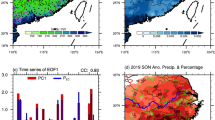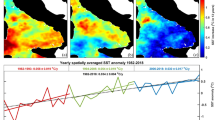Abstract
The Jiang-Huai Meiyu rainy season can be distinguished into the Jiangnan Meiyu spell and the Huaihe Meiyu spell. The Jiangnan Meiyu spell appears on the last ten days in June and the Huaihe Meiyu spell lasts from early July to middle July. An inter-decadal transition was observed in 1998 respectively from the anomalies of Jiangnan Meiyu rainfall, the sea surface temperature (SST), and the subsurface temperature in the equatorial Pacific. Since the beginning of the 21st century, opposite trends and biennial oscillations of the Meiyu rainfall are observed in the Jiangnan and Huaihe basins. Before the strong La Niña of 1999–2000, the positive SST anomalies usually occurred in the eastern equatorial Pacific. Since the beginning of the 21st century, a precursory warming signal of SST anomaly comes from the subsurface temperature which is centrally exposed near the dateline in the central equatorial Pacific. The above-normal Meiyu rainfall in 2003, 2005 and 2007 over the Huaihe basin followed the prior winterspring positive SST anomaly near the dateline. A relationship shows that the more Jiangnan (Huaihe) Meiyu follows the winter-spring warm water in the eastern (central) equatorial Pacific.
Similar content being viewed by others
References
Smith T M, Reynolds R W. Improved extended reconstruction of SST (1854-1997). J Clim, 2004, 17: 2466–2477
Behringer D W, Ji M, Leetmaa A. An improved coupled model for ENSO prediction and implications for ocean initialization. Part I: The ocean data assimilation system. Mon Wea Rev, 1998, 126: 1013–1021
Behringer D W, Xue Y. Evaluation of the global ocean data assimilation system at NCEP: The Pacific Ocean. Eighth Symposium on Integrated Observing and Assimilation Systems for Atmosphere, Oceans, and Land Surface, AMS 84th Annual Meeting, Washington State Convention and Trade Center, Seattle, Washington, 2004, 11–15
Tao S Y, Chen L X. A review of recent research on the East Asian summer monsoon in China (A). In: Chang C P, Krishnamurti T N, eds. Monsoon Meteorology. Oxford: Oxford University Press, 1987. 60–92
Huang J Y. The spatial and temporal analysis of representations of the quasi-biennial oscillation in precipitation over China (in Chinese). Chin J Atmosph Sci, 1988, 12(3): 267–273
Yang Q M. Interdecadal variations of connections between the principal biennial oscillation pattern of rain in China and global 500 hPa circulation (in Chinese). Chin J Atmosph Sci, 2006, 30(1): 131–145
Li C Y, Mu M Q. El Niño occurrence and sub-surface ocean temperature anomalies in the Pacific warm pool (in Chinese). Chin J Atmoshp Sci, 1999, 23(5): 513–521
Qian W H, Hu H R. Interannual thermocline signals and El Niño-La Nina turnabout in the tropical Pacific Ocean. Adv Atmos Sci, 2006, 23(6): 1003–1019
Ashok K, Behera S K, Rao S A, et al. El Niño Modoki and its possible teleconnection. J. Geophy Res, 2007, doi: 10.1029/2006JC003798
Weng H Y, Ashok K, Behera S K, et al. Impacts of recent El Niño Modoki on dry/wet conditions in the Pacific rim during boreal summer. Clim Dyn, 2007, 29(2-3): 113–129
Nitta T. Convective activities in the tropical western Pacific and their impact on the Northern-Hemisphere summer circulation. J Met Soc Japan, 1987, 65(3): 373–390
Huang R H, Li W J. Influence of the heat source anomaly over the tropical western Pacific on the subtropical high over East Asia. In: Proceedings of the International Conference on the General Circulation of East Asia, Chengdu, China, 1987, 40–51
Zhang R H, Sumi A, Kimoto M. Impact of El Niño on the East Asian monsoon: A diagnostic study of the ’86/87 and ’91/92 events. J Met Soc Japan, 1996, 74(1): 49–62
Wang B, Wu R G, Fu X H. Pacific-East Asian teleconnection: how does ENSO affect East Asian climate? J Clim, 2000, 13(9): 1517–1536
Zebiak S E, Cane M A. A model El Niño-Southern Oscillation. Mon Wea Rev, 1987, 115: 2262–2278
Qian W H, Zhu Y F. ENSO cycle associated with the tropospheric zonal wind anomalies over the global region. Geophysica, 2002, 38: 43–58
Author information
Authors and Affiliations
Corresponding author
Additional information
Supported jointly by National Basic Research Program of China (Grant No. 2006CB403602) and the Chinese COPES (Grant Nos. GYHY20070605 and 2006BAC03B03)
About this article
Cite this article
Qian, W., Zhu, J., Wang, Y. et al. Regional relationship between the Jiang-Huai Meiyu and the equatorial surface-subsurface temperature anomalies. Chin. Sci. Bull. 54, 113–119 (2009). https://doi.org/10.1007/s11434-008-0410-6
Received:
Accepted:
Published:
Issue Date:
DOI: https://doi.org/10.1007/s11434-008-0410-6




